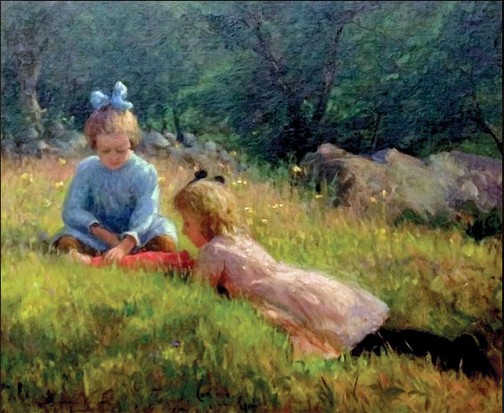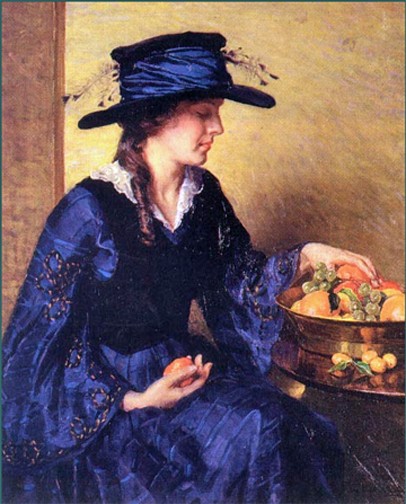Lee Lufkin Kaula, 1865 – 1957
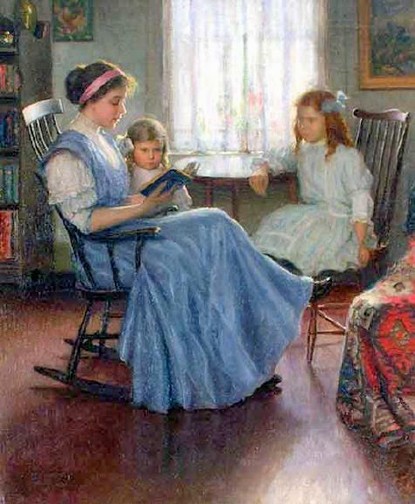
Lee Lufkin Kaula was born on December 23, 1865 in Erie, Pennsylvania into an affluent family. "Lee Lufkin’s father was a wealthy lawyer who evidently left his daughter a comfortable income that allowed the painters [Lee and her husband] to concentrate on their work without needing other jobs" (Pfarrer 2018).
A painter of genre scenes, portraits, and landscapes throughout her career, she first trained in New York with Charles Melville Dewey, the American tonalist painter who had studied in Paris and worked with Carolus-Duran on a ceiling painting at the Louvre. In 1894, Lee traveled to Paris with her artist friend Claire Shuttleworth, who would later enjoy an international reputation for her landscapes, portraits, and miniatures. Lufkin and Shuttleworth spent their summer months in Crécy-en-Brie.
Lee enrolled in classes at the Académie Colarossi and worked with genre and portrait painters Ernest Gustave Girardot and Gustave Courtois, as well as the symbolist painter and portraitist Edmond Aman-Jean. She lived at the Girls' Art Club for a time but then moved to other lodgings, staying in Paris for a total of three years (Waters 1904).
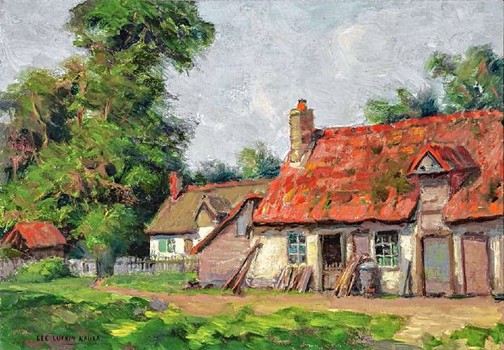
In 1894, during a trip to Crécy, France, Lee met American painter William Jurian Kaula, whom she would marry in New York City on June 4, 1902. He was studying at the Académie Julian and also at Colarossi and was absolutely "swept off his feet by Lee Lufkin and her talent" (Pfarrer 2018). She painted William's portrait in 1896 (now in the collection of the Boston Athenaeum).
While in Paris, Lee exhibited paintings at the Salon des Beaux-Arts in 1897 and 1898. According to various sources, she initially concentrated on landscapes and plein air paintings but then shifted fully to portraiture upon returning to the U.S.
The Kaulas settled in William's hometown of Boston and were some of the first tenants of the Fenway Studio building on Ipswich Street, newly rebuilt in 1905 with 46 artist studios that each featured 12-foot-high windows. The couple stayed at studio number 311 from 1906-1955. Both Lee and William studied with famed landscape artist Edmund Tarbell in Boston, who also occupied a studio at Fenway, leading them both to be nicknamed "Tarbellites."
While the husband and wife painted side-by-side in the same studio for over fifty years, their approach to painting was quite different. According to Heather R. Haskell:
Each artist created a distinctive body of work marked by technical skill and individual experience. William Kaula created beautiful celebrations of the natural landscape and Lee Lufkin Kaula displayed an astute and sensitive approach in her many portraits [...] Lufkin Kaula used the camera to capture particular moments, expressions and moods that she studied in preparation for later paintings, [...] William, on the other hand, enjoyed plein-air painting, bringing a cart with his supplies out into the countryside, to sketch the landscape before him in preparation for completing the work in his studio (cited in Urban).
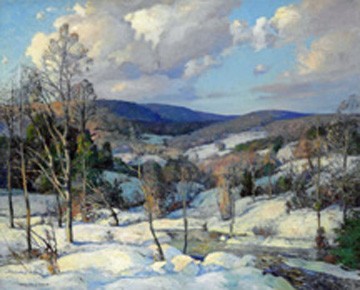
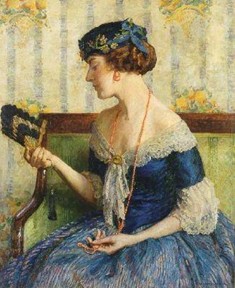
Lee Lufkin Kaula enjoyed a prolific career, exhibiting quite successfully at many important venues throughout the U.S., including:
- 1901 Pan-American Exposition in Buffalo, New York
- 1915 Panama-Pacific Exposition in San Francisco
- Art Institute of Chicago (1897-1913, 14 times)
- Pennsylvania Academy of Fine Arts, Philadelphia (1899, 1903-1927)
- National Academy of Design, NYC (1901-1922, 5 annual exhibitions)
- Boston Art Club (1903-09)
- Connecticut Gallery of Fine Arts, Hartford (1925, Honorable Mention)
- Maine Art Gallery from 1914 to 1915
A.J. Philipott, who covered the Boston Art Club's 1922 exhibition of American women painters, cited Lufkin Kaula's painting "Old Fashioned Girl" as "Another splendid bit of portrait painting [...] It is one of the most colorful pictures in the exhibition-fine in character and painted freely" (Daily Boston Globe, March 2, 1922).
She was a member of the Copley Society, the Guild of Boston Artists, the Boston Society of Watercolor Painters, and the National Society of Women Artists.
Sadly, despite all the acclaim Lee and William received in their lifetime, their prominence in American art continues to wane. Heather J. Haskell, director of the D’Amour Museum of Fine Arts in New Hampshire, attributes their fading reputation to the fact that "[...] they did not sell their work. Instead they gave their paintings [...] to friends, family members and the people who were employed at their homes" (cited in Dobbs).
Lee Lufkin Kaula died four years after William in 1957 in Ipswich, New Hampshire, their beloved summer destination, where "they cultivated beautiful and elaborate gardens [and] entertained family and friends" in the summer home they had bought in 1919 (Urban).
A retrospective exhibition honoring the Kaulas' work, "Two Lives One Passion," was held at the D’Amour Museum of Fine Arts from May 18-September 9, 2018. It was curated by Carol Scollans of the art history program at the University of Massachusetts Boston and included paintings, sketchbooks, and photographs, all originating from Stanley B. Fry's comprehensive collection:
"The work of the Kaulas caught the eye of Stanley B. Fry, a resident of Peterborough, New Hampshire, near where the Kaulas spent their summers in New Ipswich. Fry has collected not only their art, but also their correspondence, photo albums, sketch books, and copies of William's diaries" (Urban).
Some of Lee Lufkin Kaula's correspondence can be found at the Carnegie Institute, Museum of Art Records 1883-1962.
Her paintings of women in kimonos are particularly indicative of Lufkin Kaula's penchant for bright colors, rich fabrics, contrasted textures, and serene poses. As one reviewer of her 1922 show at the Copley Gallery in Boston noted: “There is something refreshing - an unusual note of color purity and luminosity - in the paintings by Lee Lufkin Kaula […] Most of them are portraits in which somehow you are made to feel that the background is vibrant in its harmony, as well as complementary in the relation to the portrait […] there is also careful drawing, fine modeling in the faces and splendid character” (Philipott).
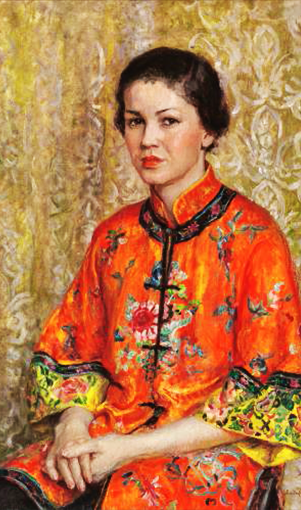
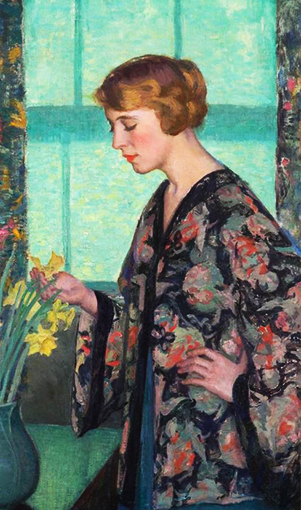
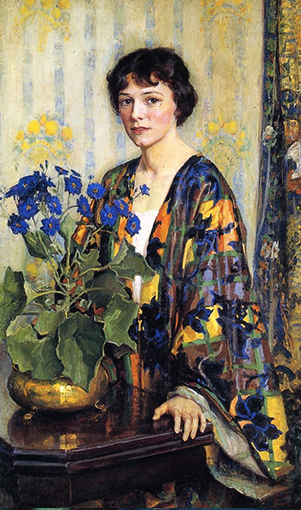
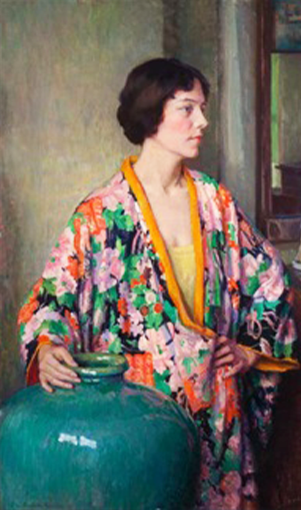
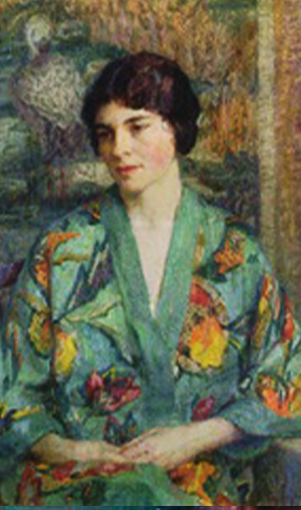
Sources
- Dobbs, G. Michael. "City museum unveils new exhibit featuring works of renowned married couple." The Reminder, May 24, 2018.
- "Exhibition of Paintings by American Women." Daily Boston Globe, Dec 29, 1928, p. 7. ProQuest Historical Newspapers.
- Fiorellino, F. "Madame Nostalgie-Lee Lufkin Kaula." YouTube.
- Fulton de K, Linda. "Art and Artists." The Buffalo Times, July 7, 1901, p. 17. Newspapers.com.
- Heller, Jules and Nancy G. Heller. North American Women Artists of the Twentieth Century: A Biographical Dictionary. Routledge, 2013, p. 229.
- Lee Lufkin Kaula, American Gallery.
- Lee Lufkin Kaula, Artnet.
- National Historic Landmark Nomination: Fenway Studios.
- Pfarrer, Steve, "Sharing Art and Life: Springfield Exhibit Celebrates Artistic Couple from New England." August 22, 2018.
- Philpott, A.J. "Purity and Luminosity in Paintings by Kaula." Boston Daily Globe, March 2, 1922, p. 6. ProQuest Historical Newspapers.
- Scollans, Carol G.J. Two Lives, One Passion: The Life and Work of William Jurian Kaula and Lee Lufkin Kaula. New Hampshire: Blue Tree, 2008.
- Urban, Cori. "Springfield Museums examines 'Two Lives, One Passion.'" Posted May 24, 2018, updated January 30, 2019.
- Waters, Clara Erskine Clement. Women in the Fine Arts, From the Seventh Century B. C. to the Twentieth Century A. D. Boston and New York: Houghton, Mifflin and Company, 1904. Google Books.
